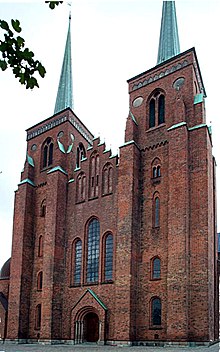Brick: Difference between revisions
rv - link to breakout game is somewhat tenous from this page |
added patent |
||
| Line 34: | Line 34: | ||
<br clear="all"/> |
<br clear="all"/> |
||
==Patents== |
|||
*{{US patent|97}} Art of manufacturing bricks and tile. Issued December 2, 1836. '' "The using of fine anthracite coal or coal dust with clay, for the purpose of making bricks or tile..." '' |
|||
==See also== |
==See also== |
||
Revision as of 14:54, 19 January 2006
- This page is about bricks used for construction. For other types of brick please see Brick (disambiguation).
A brick is a ceramic block made of kiln-fired material, usually clay or ground shale. Clay bricks are formed in a mould (the soft mud method), or more frequently in commercial mass production by extruding clay through a die and then wire-cutting them to the proper size (the stiff mud process). Brick made from dampened clay must be formed in molds with a great deal of pressure, usually applied by a hydraulic press. These bricks are known as hydraulic-pressed bricks, and have a dense surface which makes them highly resistant to weathering, and thus suitable for facing work. The shaped clay is then dried and fired to achieve the final, desired strength. In modern brickworks, this is usually done in a continuously fired kiln, in which the bricks move slowly through the kiln on conveyors, rails, or kiln cars to achieve consistent physical characteristics for all bricks. Bricks are also known in the building trades as compressed earth blocks or CEBs.
History


In the Near East and India, bricks have been in use for more than five thousand years. The Tigris-Euphrates plain lacks rocks and trees. Sumerian structures were thus built of plano-convex mudbricks, not fixed with mortar or with cement. As plano-convex bricks (being rounded) are somewhat unstable in behaviour, Sumerian bricklayers would lay a row of bricks perpendicular to the rest every few rows. They would fill the gaps with bitumen, straw, marsh reeds, and weeds. The Ancient Egyptians and the Indus Valley Civilization also used mudbrick extensively, as can be seen in the ruins of Buhen, Mohenjo-daro and Harappa, for example.
The Romans made use of fired bricks, and the Roman legions, which operated mobile kilns, introduced bricks to many parts of the empire. Roman bricks are often stamped with the mark of the legion that supervised its production. The use of bricks in Southern and Western Germany, for example, can be traced back to traditions already described by the Roman architect Vitruvius.
In the 12th century, bricks from Northern Italy were re-introduced to Northern Germany, where an independent tradition evolved. It culminated in the so-called brick Gothic, a reduced style of Gothic architecture that flourished in Northern Europe, especially in the regions around the Baltic Sea which are without natural rock resources. Brick Gothic buildings, which are built almost exclusively of bricks, are to be found in Denmark, Germany, Poland and Russia. However, bricks were long considered an inferior substitute for natural rock.
During the Renaissance and the Baroque, visible brick walls were unpopular and the brickwork was often covered with plaster. It was only during the mid-18th century that visible brick walls regained some degree of popularity, as illustrated by the Dutch Quarter of Potsdam, for example.
Construction and types

Hard-burned brick should be used for face work exposed to the weather, and soft brick for filling, foundations, and the like. The mainstay standard US brick measures approximately 8 x 4 x 2.25 inches (203 x 102 x 57 millimeters), and has a crushing strength of between 1000 and 3000 lbf/in² (7 to 21 megapascals) depending on quality. The modern standard UK brick size is 215 x 102.5 x 65 millimetres.
A highly impervious and ornamental surface may be laid on brick either by salt glazing, in which salt is added during the burning process, or by the use of a "slip," which is a glaze material into which the bricks are dipped. Subsequent reheating in the kiln fuses the slip into a glazed surface integral with the brick base.
Proportions
Regardless of size, bricks are usually manufactured with the depth equal to half the length (assuming that the brick is laid horizontally). This allows for several convenient layouts which must necessarily interweave the bricks in any structure, often both at the corners and within the wall depth in order to ensure the greatest possible durability of the structure.
Use

Bricks are typically for building. In the USA at one time, it was popular to pave roads with bricks, but they were found incapable of withstanding heavy traffic. Brick paving is again coming back into use as a method of traffic calming or as a decorative surface in pedestrian precincts.
Bricks are also used in the metallurgy and glass industries for lining furnaces. They have various uses, especially refractory bricks such as silica, magnesia, chamotte and neutral (chromomagnesite) refractory bricks. This type of brick must have a series of properties such as good thermal shock resistance, refractoriness under load, high melting point, satisfactory porosity (which can influence several other properties), all of which are high-temperature properties. There is a large refractory brick industry, especially in the United Kingdom, Japan and the U.S.A.
Patents
- U.S. patent 97 Art of manufacturing bricks and tile. Issued December 2, 1836. "The using of fine anthracite coal or coal dust with clay, for the purpose of making bricks or tile..."
